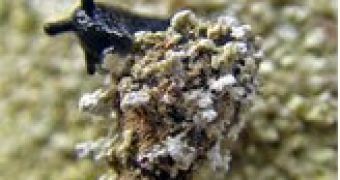Some animals mimic their environment, turning elusive for both their prey and predators, like in the case of cuttlefish and octopuses (but not of the chameleons, which also change colors). Others have to create their own camouflages. Some crabs have spikes on their back on which they thrust algae and sponges so that they are inconspicuous. Some snails have been found, too, to be adepts of a more creepy type of camouflage.
Would you oint yourself with what's on the plates for a disguise? A land snail on the Canary Islands, Napaeus barquini, feasts on crusty lichens and also implants them with its mouth on its shell, forming mounds of the mucky cover-up onto it. The camouflage is effective, as the snail can hardly be observed amongst the lichens.
But how the snails made their "invisibility" cloaks has been a puzzle till the recent study made by Christoph Allgaier of the Eberhard Karls University of Tubingen in Germany on a N. barquini population on the island of La Gomera (Canary archipelago). It has been previously believed that the camouflage was acquired accidentally and the snail was not voluntarily involved in this, while it is actually a home-made product.
The rocky surfaces where the snail lives are wrapped in nodules of lichens, in a wide range of colors and shapes. Lichens represent the symbiosis between cyanobacteria (blue-green algae) and fungi.
Field and lab observations made by Allgaier revealed that the snails first chop lichens from rock surfaces, which they mix inside their mouths with saliva for soaking and softening them. It appears that the saliva has a natural adhesive and the gastropods can lay the softened material over their shells.
While the lichen material is still soaked, the snails shape it into protuberances that stick to the shell while drying out. The snail has to stretch its body far beyond the shell margin for coating its whole shell with lichens.
"In some instances, the lichen protuberances reached a thickness up to 100 times that of the animal's shell. To ensure the crusty cape stays put, the snail somehow attaches the protuberances to the shell with mucus-like fibers. The snail possibly uses its head as a 'gluing stick' and applies additional mucus to the surface area of the protuberance and the shell," Allgaier wrote in the September issue of the journal Zoological Science.

 14 DAY TRIAL //
14 DAY TRIAL //